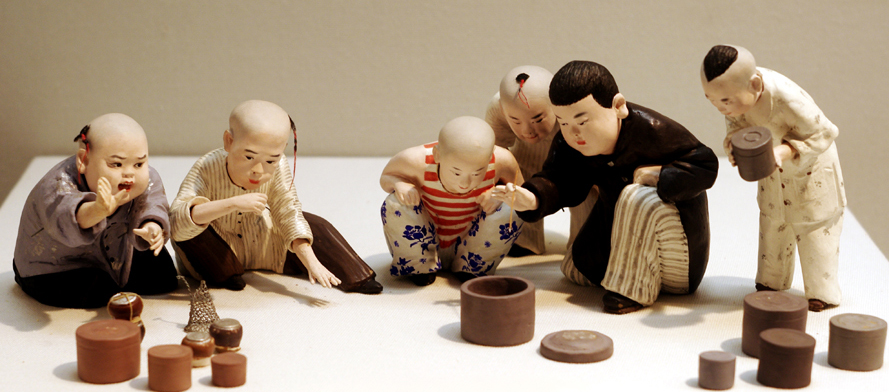Clay Figurine Zhang: Diverse yet simple

The picture is Zhang Yuting’s (1863-1954) clay figurine work “cricket fighting.” Zhang Yuting was the second-generation inheritor of the Clay Figurine Zhang style of sculpture.
The Zhang style of clay figurines, translated directly as “Clay Figurine Zhang,” has a history of more than 170 years. It was originally developed by folk craftsman Zhang Mingshan (1826-1906) in Tianjin during the late Qing Dynasty. The technique for making Zhang-style clay figurines is possessed exclusively by Zhang Mingshan’s family. They only pass it on to male family members, because people at that time thought female members would ultimately get married and leave the original family.
In the 1930s, this art met major difficulties, with many members of the Zhang family switching to other jobs due to financial hardship. Zhang Chang, the art’s fourth-generation inheritor and a professor from the Academy of Arts and Design at Tsinghua University, said at that time only he and his father Zhang Jinghu strived to continue the art.
Fortunately, after the founding of the People’s Republic of China, Clay Figurine Zhang had new development opportunities. In 1950, 59-year-old Zhang Jinghu was transferred to Beijing from Tianjin. He set up research laboratories for Clay Figurine Zhang successively in two research institutions to study this art. Since this art form was introduced to art academies and universities as part of the education on sculpture, a number of artists in this art have been trained.
In terms of styles, Zhang Chang said that Zhang Mingshan focused on small-sized portraits, and his skills reached a peak of perfection. But in modern times, the artistic style has gone through significant changes. The objects created can be as small as jewelry and as big as sculptures. Responding to doubts as to whether these creations can be considered Clay Figurine Zhang at all, he said time change, and so do people’s aesthetic sensibility. He said that art should innovate too.
Clay Figurine Zhang nowadays puts more stress on simplicity and distinctness. Nevertheless, the traditional techniques involved in the creation process, such as patting, paring, pressing and rolling, will never change, he said.

 PRINT
PRINT CLOSE
CLOSE